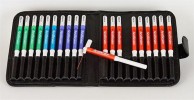Authors
Danize Aparecida Rizzetti, Francisca Fernandez, Silvia Moreno et al
Lab
Cardiovascular Physiology Laboratory, Universidade Federal do Pampa, BR 472, Km 592, Uruguaiana, Rio Grande do Sul, Brazil
Journal
Brain Research
Abstract
This study aims to investigate whether the egg white hydrolysate (EWH) acts on the neuropathic disorders associated with long-term Mercury (Hg) exposure in rats. 8- week-old male Wistar rats were treated for 60 days with: a) Control - saline solution (i.m.); b) Mercury - HgCl2 (1st dose 4.6 μg/kg, subsequent doses 0.07 μg/kg/day, i.m.); c) Hydrolysate - EWH (1 g/kg/day, gavage); d) Mercury and Hydrolysate. Mechanical allodynia was assessed using Von Frey Hairs test; heat hyperalgesia by the plantar test; catalepsy by a modification of the “ring test” and spontaneous locomotor activity by a photocell activity chambers. Analyses were performed at 0, 30 and 60 days of treatment. Brain and plasma MDA, plasma NPSH and TNF-α determination and skin immunohistochemistry were performed at 60 days. Hg induced a reduction in mechanical sensitivity threshold at 30 and 60 days and in thermal sensitivity threshold at 60 days. At the end of treatment catalepsy was developed, but there was not significant alteration in spontaneous locomotor activity. Hg also increased brain and plasma MDA, plasma NPSH and TNF- α levels and the number of Merkel cell–neurite complex in the skin. EWH prevented the development of mechanical allodynia, thermal hyperalgesia and catalepsy induced by Hg and the increase in MDA concentration in brain and plasma and in the number of Merkel cell–neurite complex in the skin. In conclusion, EWH promotes neuroprotection against the toxic effects caused by Hg, demonstrating a beneficial therapeutic potential.
BIOSEB Instruments Used:
Von Frey Filaments (Bio-VF-M)

 Pain - Thermal Allodynia / Hyperalgesia
Pain - Thermal Allodynia / Hyperalgesia Pain - Spontaneous Pain - Postural Deficit
Pain - Spontaneous Pain - Postural Deficit Pain - Mechanical Allodynia / Hyperalgesia
Pain - Mechanical Allodynia / Hyperalgesia Learning/Memory - Attention - Addiction
Learning/Memory - Attention - Addiction Physiology & Respiratory Research
Physiology & Respiratory Research
 Pain
Pain Metabolism
Metabolism Motor control
Motor control Neurodegeneration
Neurodegeneration Cross-disciplinary subjects
Cross-disciplinary subjects Muscular system
Muscular system General activity
General activity Mood Disorders
Mood Disorders Other disorders
Other disorders Joints
Joints Central Nervous System (CNS)
Central Nervous System (CNS) Sensory system
Sensory system
